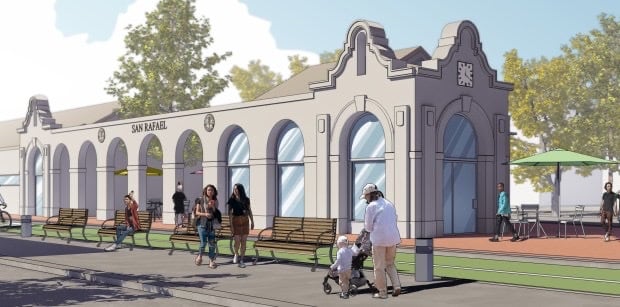San Rafael Transit Center plan hits snag
July 8, 2024
By ADRIAN RODRIGUEZ | arodriguez@marinij.com | Marin Independent Journal
See the MIJ story here

A multimillion-dollar plan to relocate the San Rafael Transit Center has run into an environmental hurdle that is driving up study costs and delaying construction.
At issue is unanticipated archeological testing and reporting that must be conducted by the Golden Gate Bridge, Highway and Transportation District, said Ron Downing, district director of planning.
That work is pending approval after several months of back-and-forth communication with the Federal Transit Administration, the agency that needs to approve the effort, he said.
All of this is needed to obtain federal clearance through the National Environmental Policy Act, or NEPA, to move forward with final design and construction, Downing said. That clearance will make the project eligible for federal funds needed to close an anticipated funding gap.
“So we’re kind of in a holding pattern right now,” Downing said. Staffers had planned to begin construction in 2026, with work lasting about a year. Staffers are now expecting a delayed start with a 2028 completion, Downing said.
The district board of directors authorized spending nearly $1 million more than planned to complete the environmental study at its meeting last week.
The approval increases the district’s contract with Kimley-Horn and Associates, the consultants supporting the effort, by $896,755. The board also approved a contingency increase equal to 10% of that amendment. That brings the total analysis and design budget to $5.6 million.
The estimated $60 million to $65 million construction plan would move the transit center one block north of its location between Third and Fourth streets in downtown San Rafael. The relocation is being pursued to address concerns about pedestrian safety and traffic flow that have arisen since Sonoma-Marin Area Rail Transit district train tracks were built directly through the transit center in 2019.
The district began its environmental analysis in 2017. In 2022, the district certified the study that satisfied the California Environmental Quality Act, or CEQA.
Downing said staff expected to use that CEQA analysis to also meet NEPA standards. However, last year the federal reporting requirements changed, Downing said.
Further archaeological testing and study is needed because it’s possible that there could be native and cultural artifacts in the soil beneath a portion of the project site. Today, the area in question is the parking lot for Citibank on Third Street. The site being study extends down Hetherton Street, Downing said.
The pending approval from the FTA will also enable the district to engage with the Federated Indians of Graton Rancheria for consultation, Downing said.
The budget amendment approved last week also allows the project team to consider some design modifications that have been raised by the community at recent public workshops, Downing said.
Two of those meetings were conducted last week. One webinar was hosted by Canal Alliance for Spanish-speaking community members. A second forum was conducted in person at Vivalon Cafe at 999 Third St.
Based on public feedback, the project team is taking a closer look at its alignment of the bike path that runs through the site, as well as the design of the reconstructed 1929 depot, which will serve as a customer service building, Downing said.
Members of San Rafael Heritage, a historic preservation group, are still lobbying for full restoration of the depot because of the history it represents. The group launched a petition in April to support their effort.
So far, the group has collected more than 800 signatures, including 524 signatures via an online petition.
Jeff Rhoads, a board member of San Rafael Heritage who is leading the petition effort, said group members hope at the very least that the depot exterior would be replicated in the new building. He said the direction the project team is headed with its design is “encouraging.”
“It incorporates both contemporary architecture and it looks at the past railroad history,” Rhoads said.
Rhoads said members of his group are also interested in the alignment for the bike path. He said moving it away from the customer service building and next to the SMART train platform could help to reduce potential conflicts with people crossing the bikeway.
Aaron Burnett, director of policy and civic engagement at Canal Alliance, said the nonprofit organization is happy to partner with the district to help inform the Spanish-speaking community.
“We are heartened by the inclusive process thus far in the design of San Rafael’s new transit center,” Burnett said. “Canal residents have shown up to share their feedback and questions at critical moments, and we have seen how their input has been incorporated into the plans as the project progresses.”
San Rafael Mayor Kate Colin had similar thoughts.
“I am appreciative that the Golden Gate Bridge district continues to gather input and analysis to ensure that the new transit center functions beautifully and is also aesthetically pleasing,” Colin said.
“This is a significant project for the city and we recognize that projects of this size take time and we will continue to support GGBTD’s efforts as a project moves along in the public planning process,” she said.